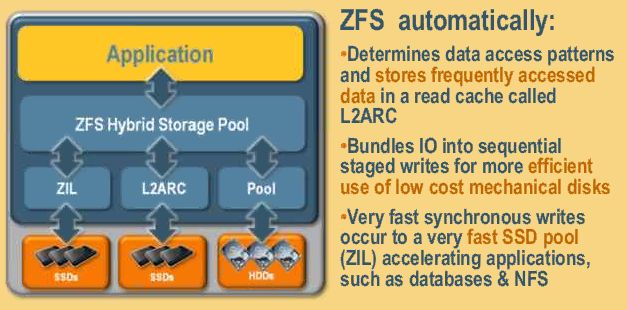GreenIT: Combining SUN-MySQL, Performance and Ecology
Months ago we underlined at the bottom of the article:
http://blog.vmengine.net/2008/05/30/marten-mickos-ceo-di-mysql-a-la-sapienza-di-roma/
related to the Roman conference of MySQL at Sapienza, about the future possibilities of creating performance using the new native ZFS filesystem of Solaris and the MySQL database engine.
Well something was born, thanks to some features of the phenomenal ZFS filesystem and the speed of SSD solid state disks, all supported by SUN devices (7000 series – openstorage line) it is possible to create Hybrid storage architectures (ZFS Hybrid Storage Pool) with SSDs and SATA disks capable of multiplying the responses of the DB Server by 17x and reducing energy consumption up to 80%, while maintaining the investment.
How is this important improvement possible?
The SUN technology that mounts very fast SSDs with no moving parts (energy saving) but much more expensive and slow capacitive and very cheap SATA disks, associated with the ZFS filesystem, it is possible to create pools of hybrid disks as in the figure:
This configuration is characterized by a 2-level cache for reads (L2ARC) and a write cache with ZFS Intent Log (or ZIL) defined on solid state disks (SSDs). The writes are then propagated asynchronously on the larger but much slower SATA disks, all this in a way that is transparent to the application.
Therefore the IO performance model is revolutionized as the following scheme:
RAM, SSDs and classic mobile disks. The RAM with the highest price/capacity ratio, followed by SSDs, then by SAS 15k disks and lastly the less performing and less expensive but very capacitive SATA disks, and it is thanks to this difference between 15k SAS disks and SATA disks that it is possible to keep the investment unchanged by improving performance and decreasing consumption, because not using SSDs we would have had to use all 15k SAS disks that for the same GB cost much more than SATA disks, so much so that we could take SSD disks and SATA disks, leaving the amount of space required unchanged.
It is important to underline again the energy savings of up to 80% that make these solutions part of the GreenIT chapter, also because SUN/MySQL are strongly pushing virtualization conceived as an increase in the number of database servers concentrated in a single large machine, taking advantage of an optimal use of hardware and the fast provisioning dynamics typical of virtualization.


